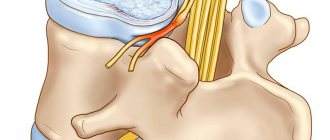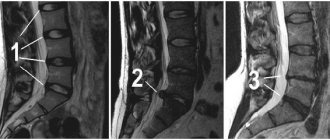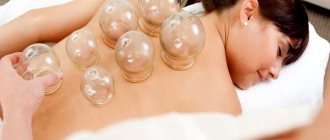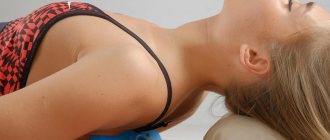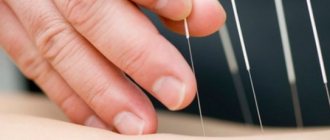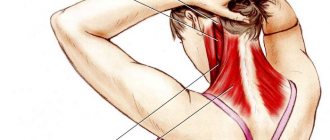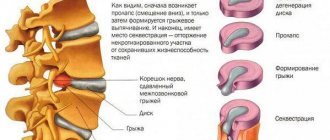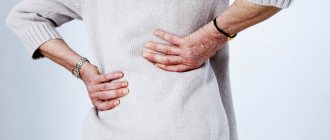Book a massage
Spinal protrusion is a pathological condition considered to be a precursor to intervertebral hernia. At this stage of the disease, the fibrous ring is not torn, so this pathology is considered reversible. Protrusion of intervertebral discs is caused by degenerative-dystrophic processes provoked by a sedentary lifestyle, difficult working conditions, injuries or impressive force loads on the spine, non-compliance with the drinking regime, and diseases of the nervous system. The development of spinal protrusion is indicated by pain and severe discomfort in the back, numbness, weakness, tingling and spreading pain in the limbs, frequent dizziness, causeless fatigue and general weakness.
Massage for spinal protrusion
This pathological condition, if detected in the early stages, cannot be treated with anti-inflammatory drugs. Massage is prescribed as an additional, more effective therapy. Its professional implementation can not only reduce, but also completely eliminate disc protrusion. Ignoring this pathological condition will lead to worsening negative symptoms and the development of complications. In its advanced state, this disease can be treated exclusively surgically. To prevent this, massage for protrusion is prescribed immediately after confirmation of the diagnosis, and not just once, but in courses.
Massage for lumbar protrusion
What is protrusion of the lumbar spine?
As you know, there are 5-6 vertebrae in the lumbar region. Between their bodies there are fibrocartilaginous formations - intervertebral discs. They receive the necessary nutrients diffusely through the existing surfaces and blood vessels of the vertebrae. The main purpose of formations of a cartilaginous nature is to create an intervertebral layer that provides the necessary elasticity and mobility of the spinal column, and is also responsible for maintaining its stability and integrity.
Due to the aggressive influence of the external environment, age factors, physical inactivity and other negative aspects, the blood supply and nutrition of the disc can be significantly impaired. This is accompanied by the occurrence of degenerative changes and the subsequent development of osteochondrosis.
Ignoring the problem is fraught with the progression of structural and functional disorders, deformation of intervertebral discs and their sclerosis. Due to this, the process of nutrition of the nucleus pulposus is disrupted, which is accompanied by loss of moisture. This provokes the development of protrusion of the intervertebral discs of the lumbar region.
We are talking about a situation that is characterized by complete destruction of the disc, a significant change in its shape, thinning of the fibrous ring and its slight extension beyond the vertebrae. In turn, insufficient supply of nutrients and water is fraught with delamination and rupture of the collagen structures that make up the outer shell of the disc.
This contributes to a change in the position of the nucleus pulposus and its movement into the thinning zone, which is fraught with excessive load on the fibrous ring that has undergone deformation. Over time, it loses its ability to withstand increased pressure, and even more collagen structures rupture, which is accompanied by protrusion of the disc into the space inside the spinal column.
Useful tips
When treating spinal protrusion in addition to treatment methods during exacerbations (relapses), we strongly recommend that patients adhere to a gentle regimen. Limiting physical activity will prevent deterioration of the condition and further injury to the spinal roots, and will prevent the development of aseptic inflammation. When carrying out rehabilitation actions you should:
- avoid heavy activities, especially heavy lifting;
- constantly wear special orthopedic devices (soft bandages, Shants collars, elastic corsets);
- strictly follow all recommendations of our specialists;
- In case of disc protrusion during treatment, it is necessary to strictly adhere to the developed treatment method and not make adjustments on your own.
Self-medication is strictly prohibited. A frivolous attitude towards one’s own health leads to a deterioration in the condition and the development of severe complications, leading the patient to the need for complex surgical operations with a long and difficult recovery period. For example, paramedian protrusion of the intervertebral disc, in the presence of which there is complete prolapse of the nucleus pulposus, can lead to immobilization.
With the timely detection of intervertebral disc protrusions, every person should know what to do and how to help themselves or not harm themselves. We invite you to visit our specialized clinic - we can answer all your questions and help with almost any diagnosis, with the help of our experienced specialists we will provide competent treatment.
The article was reviewed by Professor, Dr. med. Sciences, neurologist Ronami V.G.
Stages and types of lumbar protrusion
Depending on the intensity of the lesion, there are three forms of the disease:
- Easy. In this case, the protrusion measures no more than 1 mm. There is a slight protrusion, which is difficult to determine even with the help of high-precision diagnostic equipment;
- Moderate. There is an increase in protrusion up to 2-3 mm;
- Heavy. A noticeable protrusion of the intervertebral disc is observed. If it can be clearly visualized beyond the vertebrae, since its dimensions can already reach 5-6 mm. However, the integrity of the fibrous ring can still be preserved.
The third stage of the disease can provoke the appearance of an intervertebral hernia. This is due to the increased risk of rupture of the annulus fibrosus, since at this stage it becomes significantly thinner and may not withstand excessive pressure. As a result, the nucleus pulposus migrates beyond the anatomical boundaries of the disc and a herniation occurs.
A key role when choosing a treatment method for protrusion of the lumbar spine is played by its location in relation to the central axis of the internal cavity of the spinal column. There are the following types of protrusions:
- Dorsal. When dorsal protrusion of the lumbar discs occurs, the protrusion occurs into the posterior part of the spinal column;
- Foraminal. In this case, the protrusion penetrates the outlet openings of the spinal column through which the nerve endings pass;
- Lateral. The formation of pathology takes place in the left or right part of the spine;
- Circular. There is a thinning of the fibrous ring over the entire surface and its uniform bulging into the internal space of the spinal column;
- Median. The localization of the protrusion is observed in the central part of the spinal canal, in the area of the massive junction of nerve fibers.
Ball exercises
Exercises with a ball are no less effective for lumbar protrusion. For this purpose, you need to purchase a fitball - a large elastic sports ball.
- You need to lie on the ball with your stomach and hips, it is advisable to fix your legs. The feet can be held still by an assistant. Or you can catch them on a bench or a radiator in the room. Next, folding your arms across your chest, you need to raise and lower your torso without arching your back, maintaining a straight line to your torso.
- You can perform rolls on a fitball while lying on your stomach or back, but be careful not to fall. You can also rest the ball against a vertical surface (wall), press your lower back against it and roll up and down, left and right.
- Experts advise not to do exercises with a fitball at home alone. It is advisable to have another person in the room, preferably a coach or instructor. It’s even better to conduct such classes in the gym or in a specially equipped room in the outpatient clinic of a medical institution.
What factors cause disc protrusion?
Most often, the key cause of the disease is osteochondrosis. The appearance and progression of the disease also contribute to:
- Physical inactivity, prolonged stay in one position (drivers, office workers, etc.);
- Violation of metabolic processes;
- Increased loads on the spinal column associated with sports activities or heavy physical labor;
- Weakness of the muscle corset;
- Spinal injury;
- Overweight;
- Pathological change in the configuration of the spine;
- Disorders associated with aging of the body;
- Wrong diet.
Symptoms of protrusion of the lumbar spine
First of all, with the development of this pathology, patients note the appearance of pain. Moreover, significant pain can make itself felt even at the initial stage of the disease, before the formation of a hernia. Sometimes such unpleasant manifestations cannot be stopped even with analgesics. At the same time, the motor function of the spine in the lumbar region may be impaired.
It should be noted that some patients learn about the presence of pathology only after the protrusion acquires massive dimensions, while others note the appearance of pain at an early stage of the disease. This suggests that the parameters of the hernia do not play a decisive role in deciding whether surgical intervention is necessary.
First of all, doctors pay attention to the clinical manifestations of the patient, since in some situations the indication for surgery is a narrowed spinal canal and a slight protrusion.
The appearance of acute pain may indicate pinched spinal nerves. But most often the pain is dull and aching in nature, or can be expressed in the form of lumbago. In this case, it radiates to the lower leg, thigh or lower limbs.
As a rule, pain manifestations make themselves felt when:
- Increased physical activity;
- Changing the position of the body;
- Staying in one position for a long time.
When studying the question of what protrusion of the discs of the lumbar spine is, the following disorders should be taken into account:
- The appearance of a sharp pain syndrome when trying to bend or turn the body;
- Deterioration of sensitivity, which is accompanied by a sensation of “goosebumps” on the skin, numbness or tingling in the lumbar region;
- Deterioration of muscle tone in the lower extremities and the appearance of spasms in the affected part of the spine;
- Dysfunction of the pelvic organs. It makes itself felt in the presence of a narrowed spinal canal and compression of the nerve endings responsible for the functioning of the reproductive system, intestines and bladder;
- Increased fatigue, inability to perform the usual amount of work.
Main features
The main symptom is pain. It can be discogenic, localized in the lumbar dermatome, or radicular. The latter is characterized as sharp, shooting. It occurs when performing certain movements, and intensifies at night. Radicular pain extends to the lower limb.
When the root is compressed, dermatomal pain appears. The localization of such pain depends on which root is compressed. With compression of the L1 root, patients report pain in the inguinal dermatome. Complaints of pain in the anterior and lateral surface of the mid-thigh indicate compression of the L2 root.
Pain in the inner and anterior lower part of the thigh is noted with compression of the L3 root. Localization of pain in the anterior or posterior part of the leg is a sign of compression of the L4 P root, and the lateral area - of the L5 P root. In the latter case, the pain spreads to the patient’s foot area.
Pain in the lateral area of the feet indicates compression of the S1 root. When S2 is compressed, pain is noted in the femoral area and in the lower leg area.
Tingling is noted along the dermatome of the L1-S2 nerve roots. Numbness also spreads in this area. Severe pain in the patient is caused by muscle spasm associated with the accumulation of lactic acid in them. It occurs between the vertebrae L1 and L5.
As a result of lumbar protrusion, patients feel weakness in the lower limb, and movements are difficult for them. If the L1 and L2 roots are affected, problems with hip flexion occur. If, in addition to this, the patient extends the knee joint with force, there is a problem at the level of the L3 root.
Movement in the knee joints and extension of the toes becomes more difficult when the L4 root is damaged. The big toe cannot be raised upward if L5 is affected. Muscle weakness when performing movements in the knee joints is characteristic of damage to the S1 root.
In addition, damage to the L4-5 and S1 roots leads to a decrease or complete disappearance of the Achilles reflex in the patient. An abnormal knee reflex indicates pathology of the L2 and L3 roots.
With protrusion, patients lose their appetite, as a result of which their weight decreases. Loss of muscle mass is a major cause of weakness and leads to wasting limbs. Due to constant pain, patients suffer from insomnia. In severe cases, as a result of worsening pathology, the functions of the bladder are disrupted. The patient may also lose control of bowel movements.
It is recommended to consult a doctor when the first symptoms of protrusion appear, then the treatment will be short and most effective.
Diagnosis of lumbar protrusion
During the initial visit to a specialist, the patient is examined to determine neurological disorders. An experienced doctor can immediately assume the presence of a protrusion. But to make an accurate diagnosis, instrumental diagnostics are performed, since many pathologies of the spinal column can be characterized by identical neurological manifestations.
It is mandatory to:
- CT;
- MRI;
- Radiography.
The medical history is also carefully studied and the neurological status is assessed. This makes it possible to determine:
- The period of onset of pain, its intensity and nature, as well as the frequency of its occurrence;
- The ability of muscles to overcome external resistance, the quality of the process of coordinating muscle activity, establishing the relationship between periods of increasing pain and individual movements;
- Determination of range of motion;
- the level of physical activity of the patient before the onset of the disease and at the present time;
- State of tactile receptors;
- Identify the possibility of vertebral displacement and parameters of the intervertebral space.
MRI is considered the most informative method for obtaining a detailed picture of the condition of the discs. Using this diagnostic method, it is possible to identify protrusions at a very early stage of development, when their sizes are minimal.
In some situations, the patient is sent for radiography with functional tests. This is one of the safest and most accurate research methods. Using it, it is possible to establish the possibility of displacement of the vertebrae, visualize the vertebral structures as clearly as possible, determine the distance between the discs and identify mobility in certain areas of the spinal column.
Make an appointment Online booking
- Clinic on Krasnopresnenskaya +7 (499) 252-41-35 Volkov lane, 21
- Clinic on Varshavskaya +7 (499) 610-02-09 Varshavskoe highway, 75, building 1
- Clinic in Annino +7 (495) 388-08-08 Varshavskoe highway, 154, building 1
Treatment of protrusion of discs of the lumbar spine
If a doctor suspects that a patient has a protrusion of the lumbar spine, he must carefully study the symptoms of the disease and select treatment in accordance with the existing clinical manifestations and the results of the studies. In the early stages of the disease, conservative methods of treatment are resorted to. Most often they are aimed at obtaining the following effects:
- Relief of inflammatory foci and pain relief, which has a beneficial effect on the condition of the spinal cord;
- Normalize blood circulation, which helps improve metabolism and cellular nutrition of the intervertebral discs;
- Stop destructive and degenerative processes in the area of the fibrous ring and eliminate the possibility of hernia formation;
- Restore motor activity in the area of the damaged area of the spinal column;
- Avoid the occurrence of muscle weakness.
Use of medications
The effectiveness of treatment for protrusion of lumbar spinal discs mainly depends on how well the medications are selected. Taking into account the intensity of the damage, experts recommend taking:
- Corticosteroid hormones. They allow you to stop the inflammatory process and are used during the period of exacerbation, in case of serious destructive changes;
- Non-steroidal anti-inflammatory drugs. Helps eliminate pain and reduce inflammation. Can be used both in tablet form and as gel-like products and ointments;
- Chondroprotectors. Provide the ability to quickly restore cartilage, accelerate metabolic processes;
- B vitamins. Help normalize the ability to conduct nerve impulses;
- Products containing calcium. Strengthens bone tissue.
It should be noted that if a patient has protrusion of the lumbar intervertebral discs, treatment must be selected individually, taking into account the characteristics of his body. Moreover, all medications are taken in long courses, depending on the intensity of the lesion.
The influence of physiotherapeutic procedures
Thanks to physiotherapy sessions, it is possible to significantly improve the patient’s condition and stop the development of pathological processes in the area of the intervertebral disc. To achieve a positive effect, about 10–15 procedures are required, which are selected individually.
Patients diagnosed with lumbar or sacral disc protrusion can get the best health results by:
- The procedure for exposure to low power electric current. Thanks to electrophoresis, it is possible to accelerate the penetration of drugs into the affected area and provide a noticeable anti-inflammatory and analgesic result;
- Traction traction of the spine. The procedure is performed using special equipment. With its help, it is possible to expand the spaces between the vertebrae and minimize excessive load on the discs;
- UVT. It is used to identify various curvatures and deviations in the spinal column, helps eliminate compression of nerve endings and significantly improves muscle tone;
- Impact on the affected area with a laser. Due to this, it is possible to restore the nutrition of the disc tissue with useful substances and oxygen, improve metabolism, normalize the activity of the immune system and reduce the intensity of pain;
- Magnetotherapy. Helps improve blood circulation, restores the functioning of one’s own immune system, helps regulate the process of saturating disc tissue with nutrients;
- Staying at resorts with thermal or mineral springs. Promotes full recovery of the whole body, normalization of the emotional background, and can play a preventive role.
It should be noted that the best results from the use of physiotherapeutic methods can be obtained in protrusions of minor severity.
Shock wave method for spinal protrusion
This method is based on the impact of high-power acoustic pulses on tissue. In this case, local, targeted work is performed on the affected areas, which eliminates injury to nearby tissues. Using this procedure, it is possible to restore blood circulation in the affected area, activate metabolism and accelerate the transport of nutrients through cell membranes.
The key advantage of the technique is safety for the patient. However, the possibility of its implementation during pregnancy and breastfeeding is excluded. Limitations also include the presence of malignant neoplasms in the patient’s body.
According to statistics, the shock wave method has proven to be highly effective for several thousand patients suffering from protrusion of intervertebral discs. Therefore, trying to find an unambiguous answer to the question: “How to treat protrusion of the lumbar spine?”, we can conclude that shockwave therapy is advisable.
In our medical]SWT[/anchor] course is carried out using the latest Swiss equipment, under the guidance of experienced specialists, with a guarantee of successful and long-term results.
Special exercises for protrusion of the lumbar spine
Exercise therapy is considered one of the most important components of effective treatment of protrusion. In this case, a set of exercises is selected for each patient individually, taking into account the state of his body, the presence of chronic diseases and the degree of physical activity.
In general, physical therapy, provided that the exercises are performed daily, helps to obtain the following positive effects:
- Increase muscle strength;
- Minimize the load on the affected area;
- Restore the tone of the whole body;
- Improve the supply of diseased areas with nutrients and normalize metabolism;
- Increase the space between the vertebrae and prepare the way for the release of nerve endings.
According to clinical studies, the above method makes it possible to stop pathological processes in the lumbar region and prevent their further development.
It is important to remember that to achieve the desired result, a set of exercises must be performed slowly, with a gradual increase in load.
Massage for protrusion of the lumbar spine
In order to improve lymph outflow, normalize blood flow, accelerate metabolism and restore the anatomical features of the spinal column, massage procedures and manual therapy are performed.
The use of manual pressure methods allows you to strengthen muscles, improve the functioning of tactile receptors and eliminate compression of nerve endings. However, in advanced stages of the disease, this technique is not used.
Features of the diet
To understand how to treat lumbar protrusions with the greatest effectiveness, you should pay special attention to the patient’s motor activity. When diagnosing this method, it is necessary to adhere to the principle of the “golden mean” - not only to exclude increased loads on the lumbar region, but also the factor of physical inactivity. This indicates the need for regular walks in the fresh air and at the same time refusal to transport heavy objects.
Experts also recommend adhering to a special diet enriched with protein and calcium-containing foods, which include:
- Chicken meat;
- Dairy products;
- Fish delicacies;
- Veal;
- Nuts;
- Vegetable salads;
- Greenery.
Also, do not neglect products containing natural gelatin: marmalade, seaweed, meat soups, etc. In this case, alcoholic beverages, foods with a high fat content, and fried foods should be excluded from the diet. Overweight patients are advised to adhere to a strict diet and begin to perform a special set of exercises, which will reduce the increased stress on the spinal column.
Surgical intervention
In approximately 5–10% of cases of protrusion, patients are recommended to undergo surgery. In particular, the need for it arises:
- With an increased incidence of pain;
- In the absence of positive dynamics within 21-35 days from the start of treatment;
- The presence of chronic radicular syndrome;
- In the presence of a narrow spinal canal;
- If the patient's health rapidly deteriorates.
At the moment, the most popular and effective methods are those that allow one to obtain an effective result with minimally invasive intervention (puncture nucleoplasty). Due to this method, it is possible to minimize the compression in the inner part of the disc and return it to its standard shape.
Prevention
After surgery, the patient must undergo a course of rehabilitation, otherwise he may experience a relapse of the disease. During this period, it is useful to do swimming, yoga, Pilates, and walking. Exercises must be systematic and performed in compliance with the biomechanics of movements.
Therapy for thoracic protrusion should be comprehensive and include taking medications in parallel with physical activity. In the initial stages, the pathology is easily treated. With a more extensive formation, it takes several weeks just to eliminate the pain. Normalization of the spine takes months. If you follow your doctor's recommendations and exercise regularly, the prognosis is favorable. Even after surgery, the patient’s motor activity is not impaired.
Preventive measures and possible complications
If you ignore the problem and do not want to contact a specialist, the pathology can become progressive. This is fraught with the appearance of acute pain, compression of the spinal roots, rupture of the fibrous ring and the formation of a disc herniation. Moreover, prolonged compression of nerve endings can lead to paralysis in the legs and malfunction of the pelvic organs. Such negative manifestations can only be eliminated through surgical intervention. During the rehabilitation period, it is necessary to minimize the load on the spine, avoid prolonged stay in an uncomfortable position, lose weight, take daily walks in the fresh air, practice physical exercise and maintain a healthy lifestyle.
Causes
Protrusions of the thoracic region occur due to the destruction of the walls of the intervertebral discs. This happens when their trophism is disrupted. In the thoracic spine, pathology is least often detected, since it is the least mobile and least susceptible to stress.
Among other reasons, doctors identify:
- sudden injuries caused by blows, falls, accidents;
- improper performance of physical exercises, in particular a combination of bending and twisting;
- genetic factors;
- chronic diseases of the spine: scoliosis, osteochondrosis;
- posture disorders;
- constant sitting;
- sudden movements;
- lack of nutrients.
Protrusions of the thoracic region are most often diagnosed in middle-aged and older patients, which is explained by age-related changes.
